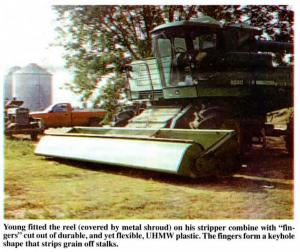1994 - Volume #18, Issue #6, Page #23
[ Sample Stories From This Issue | List of All Stories In This Issue | Print this story
| Read this issue]
He Built His Own Stripper Combine
 |
Stripper headers pull grainheads off standing stalks of grain, leaving the stalks standing and feeding only grain and chaff through the combine. They were developed in England and are now being marketed in North America by Massey Ferguson. The idea has caught on in certain areas of the country, particularly the Northwest, where wheat yields tend to be the heaviest, and the Mid-South in rice country.
Young started with a 22-ft. wide Deere 222 grain header and fitted it with his home-built stripper reel fitted with heavy plastic "fingers" that strip the stalks yet leave them standing. The biggest benefit of the process is that less crop material feeds through the combine so you can go faster and do a better job cleaning.
"It can be used on any small grain crop where the seed is exposed. Since grain is already threshed when it enters the combine, the machine uses only about half as much fuel. Tilling of the soil is easier since you don't have to deal with mounds of chopped straw. And because only a fraction of the residue enters the combine, there's much less grain loss. It also reduces wear and tear on the combine and saves labor. I figure I save $9,000 to $11,000 a year on grain savings, wear and tear, fuel and labor, and I'm able to complete harvest two weeks earlier, which is a big help if you plan to double crop."
The stripping rotor is housed under a sheet metal housing that rests above and in front of the header. Young used a 22-ft. long piece of 10-in. dia. pipe for the rotor, welding a plate on each end with a center 1 1/2-in. dia. shaft for bearings. It's fitted with 8 pieces of 2 by 2-in. angle iron 22 ft. long that hold the plastic stripping fingers. He used 9 sheets of 4 by 8-ft. 16-ga. sheet metal to make the housing and a vertical shield that goes behind.
Stripping fingers were cut out of two 4 by 10-ft. pieces of 1/4-in. thick UHMW, a durable yet slightly flexible plastic that's used on commercial strippers. He cut out the fingers individually and bolted them to the 2 by 2 angle irons, which attach directly to the 10-in. center pipe. Young notes that he also could have purchased stripping fingers from the manufacturer but that they would have cost nearly $4,000.
Lubrication consists of just two greasable bearings and two chains that need oiling every 10 hrs. of use. "The stripping fingers are expected to last about 2,500 acres with a replacement of just $140 if you make them yourself, plus labor. It's very low maintenance compared to a conventional header," notes Young, adding that "anyone who has ever harvested small grains with a conventional combine will quickly catch onto this simple harvesting technique."
Contact: FARM SHOW Followup, Todd Young, Knobel, Ark. 72435.

Click here to download page story appeared in.

Click here to read entire issue
To read the rest of this story, download this issue below or click here to register with your account number.




